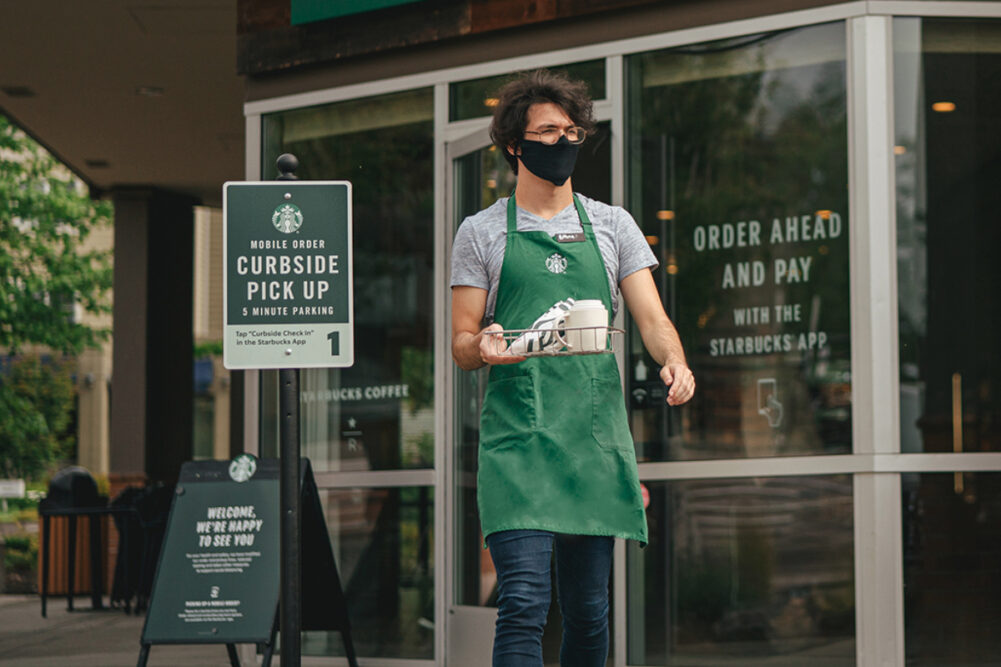SEATTLE — Executives of Starbucks Corp. are expecting comparable store sales to bounce back in 2021, forecasting double-digit growth after the coronavirus (COVID-19) led to double-digit declines in that area in fiscal 2020. Installing curbside pickups at hundreds of stores in US suburbs factors into the growth forecast while the company also plans to close under-performing stores in dense metro areas.
“Barring any new significant and sustained waves of COVID-19 infections and/or global economic disruptions, we expect global comparable store sales growth of 18% to 23% in fiscal 2021 fueled by sustained improvement in comparable store transactions across both of our key markets, the US and China,” said Patrick J. Grismer, chief financial officer and executive vice president of Seattle-based Starbucks, in an Oct. 29 earnings call. “These estimates are based on the experience we've gained from navigating the impact of COVID-19 for the past nine months, including the more resilient operating protocols that we've built into our business as well as the traffic-driving initiatives and innovations that we've planned for the year ahead.”
Starbucks expects comparable store sales growth of 17% to 22% in the Americas and the United States, which assumes cafe seating is near full capacity and operating hours are near normal by the end of the second quarter, Mr. Grismer said.
“Broadly speaking, we've seen US transactions migrate from dense metro centers to the suburbs, from cafes to drive-thrus, from early mornings to mid-mornings with outpaced recovery on the weekends,” said Kevin R. Johnson, president and chief executive officer. “We've adjusted our operations to match these new customer behavior patterns, including multiple new protocols to provide a safe experience for our partners and customers, and this has resulted in customer connection scores, which are well above prior year levels.”
In the Americas and the United States in fiscal 2021, Starbucks plans to open about 850 stores while closing about 800 stores.
“The closures are part of the trade area transformation initiative that we announced in June to accelerate the evolution of our store footprint in dense metro centers, clearing the way for the development of new, more efficient retail store formats that cater to customers' increasing desire for convenience while also improving trade area profitability,” Mr. Grismer said.
Starbucks in June announced plans to close up to 400 stores in the United States and 200 in Canada. Now the company’s guidance for fiscal 2021 includes plans to close an additional 200 stores, Mr. Grismer said.
To increase throughput and accommodate higher transaction volumes at suburban locations, Starbucks has rolled out curbside pickup to about 800 US company-operated locations, Mr. Johnson said, adding curbside pickup is on track to be at nearly 2,000 US stores by the end of fiscal 2021. Starbucks also has introduced handheld point-of-sale devices to about 100 stores and has a goal of deploying the devices to about another 400 stores by the end of the first quarter.
Other projections for fiscal 2021 include consolidated revenues of $28 billion to $29 billion and earnings per share in the range of 32¢ to 37¢ in the first quarter and $2.34 to $2.54 in the fiscal year.
The upbeat guidance comes after Starbucks for the fiscal year ended Sept. 27 reported net earnings of $928.3 million, or 79¢ per share on the common stock, which was down 74% from $3.60 billion, or $2.92 per share, in the previous fiscal year. Consolidated net revenues declined 11% to $23.52 billion from $26.51 billion primarily due to lost sales related to COVID-19.
Comparable store sales in the 2020 fiscal year declined 14% globally, which included 12% in Americas and the United States and 19% in International. In the fourth quarter, comparable store sales declined 9% both globally and in Americas and the United States and 10% in International.
“I could not be more pleased with our US sales recovery, which progressed faster than we anticipated in our final quarter of fiscal 2020,” Mr. Johnson said. “We finished the quarter with a comparable store sales decline of 4% for the month of September, a vast improvement from the approximately 65% decline we experienced at the depth of the pandemic only five months ago.”
In Americas and the United States, operating income fell 46% to $510.3 million from $938.9 million. Net revenues decreased 9% to $4.23 billion from $4.65 billion.
In International, operating income fell 32% to $179.5 million from $262.7 million. Net revenues were down 5% to $1.49 billion from $1.57 billion. Starbucks’ business continues to recover in China, where comparable store sales declined 3% in the fourth quarter but were up 1% in September. Starbucks expects comparable store sales in China to fully recover by the end of the first quarter and to grow between 27% and 32% in the fiscal year, Mr. Grismer said.
In Channel Development, operating income slipped 1.5% to $687.2 million from $697.5 million. Net revenues declined 3.4% to $1.93 billion from $1.99 billion. In the United States, sales of Starbucks’ packaged coffee grew by 15% in the fourth quarter, Mr. Johnson said.
“Somewhat offsetting this strength was softness in the foodservice business as offices, hotels, colleges and entertainment centers continue to experience low levels of traffic,” he said.
Companywide in the fourth quarter, Starbucks reported net earnings of $392.6 million, or 33¢ per share on the common stock, which was down 51% from $802.9 million, or 67¢ per share, in the previous year’s fourth quarter. Net revenues in the quarter declined 8% to $6.20 billion from $6.75 billion.





